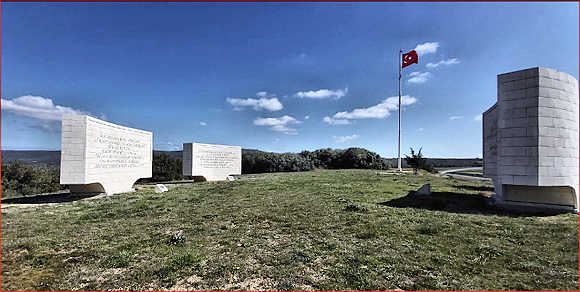 |
| Scimitar Hill Today |
The Battle of Scimitar Hill was a major piece of the last offensive mounted by the British at Suvla during the Battle of Gallipoli in World War I. It was also the largest single-day attack ever mounted by the Allies at Gallipoli, involving three divisions. The purpose of the attack was to remove the immediate Ottoman threat from the exposed Suvla landing and to link with the ANZAC sectors to the south. Launched on 21 August 1915 to coincide with the simultaneous attacks on Hill 60 and W Hills to the south The attacks south were defeated, and the attack on Scimitar Hill was a costly failure, in which the Turks were forced to use all their reserves in "severe and bloody fighting" far into the night, with some Turkish trenches lost and retaken twice. For the third time in the Gallipoli Campaign, the Allies had the misfortune of confronting forces under the command of Mustafa Kemal, who uncannily reinforced Hill 60 and Scimitar Hill at critical moments in the fighting.
The attack on Hill 60 was a failed attempt by the Allies to capture a prominent hill feature between Anzac Cove and Suvla Bay. The attack was led by General Cox and his 3,000 troops, fighting continued there after 21 August but that attack was abandoned by Anzac commander William Birdwood on 28 August. Meanwhile, the attempt to capture the West Hills also failed. The division sent to capture the hills lost its bearings and was unable to find its way.
 |
| Turkish Commander Mustafa Kemal During the Fighting at Suvla |
Following a preparatory but ineffective artillery barrage starting at 1430 hours on 21 August 1915, the 29th Division attack on Scimitar Hill, began at 1500 hours through scrub that had been ignited by the artillery fire.The attempt initially succeeded despite the dense smoke, the crest was reached about 1600 hours. Unfortunately, the men were in an untenable position as Turkish artillery from the Anafarta Hills to the East brought deadly direct fire to bear while the immediate enemy stood on their parapets firing from the hip and throwing hand grenades.
 |
| Allied Commander de Lisle (Seated) During the Fighting—Note Contrast with Kemal Above |
As the day wore on and attack after attack broke under the fire of the resolute defense, the brush caught fire and hundreds of wounded lying in the open ground between the lines were cremated alive; the sights and sounds of that day would never be forgotten by the survivors. Reserves sent by IX Corps Commander MG Henry de Beauvoir de Lisle were thrown back after suffering heavy losses while charging uphill.
 |
| Turkish Monument Atop Scimitar Hill |
Allied casualties in the Scimitar Hill action reached some 5,300, many of which were incurred after British artillery shrapnel resulted in surrounding bush catching fire. Turkish losses were put at 2,600. Demoralized by the mounting losses, Hamilton telegraphed war minister Lord Kitchener in London with a request for another batch of troop reinforcements, this time comprising 95,000 men. Kitchener offered 40,000, but the government in London was already considering evacuation options.
Sources: The History Junkie, It's a Long Way to Gallipoli; Wikipedia; Australian Military History podcast

What were these men thinking? The wisdom of hindshight of course blurs the decisions made at the time ...Margaret Australia
ReplyDelete